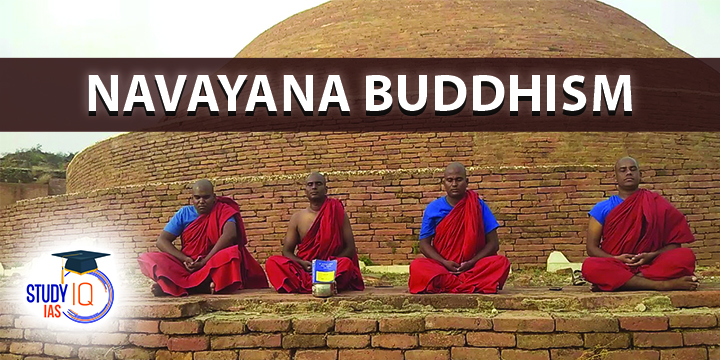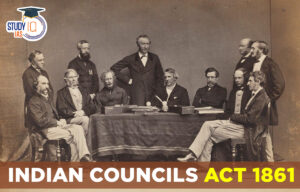Table of Contents
Navayana Buddhism Beliefs
- Navayana Buddhism: Dr Ambedkar, in 1935, announced his decision to renounce Hinduism, as a way to challenge the caste order.
- The decision to embrace Buddhism arrived after detailed study on various religions to understand the suitability of each to liberate socially marginalised communities.
- Ambedkar embraced Buddhism in Nagpur’s Deekshabhoomi, along with more than five lakh followers.
- The event is seen as the renaissance of Buddhism in India. Ambedkar called this version of Buddhism as Navayana (followers are called neo-Buddhists), separating it from the Mahayana and Vajrayana traditions of Buddhism.
- Navayana means “new vehicle” and is a newer branch of Buddhism, distinct from Theravada and Mahayana.
- Features of Navayana Buddhism in India:
- Modern and rational: Older Buddhism fulfilled the basic requirements of attaining modernity but Ambedkar’s idea of Buddhism was said to be more modern than the ancient form of Buddhism due to its emphasis on individual choice.
- Basic French Principles: Ambedkar’s version of Buddhism contained in it the basic principles of French revolution, namely liberty, equality and fraternity.
- Renunciation of traditional Buddhist practices: The traditional Buddhist practices such as institution of monk after renunciation, ideas such as karma, rebirth in afterlife, samsara, meditation, nirvana and Four Noble Truths were omitted from Navayana.
What is Buddhism Religion
- Buddhism is based on the teachings of Gautama Buddha. The religion gained popularity during the reign of Emperor Ashoka.
Buddhist Councils and Places:
- First Buddhist council: The first council was held in Rajgriha under the patronage of King Ajatashatru. Mahakasyapa presided over the council.
| Hinayana | Mahayana |
| Followers consider Buddha as an ordinary being who attained Nirvana. | Followers consider Buddha as a divine being who guided his followers to Nirvana. |
| Hinayana followers used Pali language. | Mahayana followers used Sanskrit language. |
| Does not endorse idol worship. | Believes in idol worship. |
| Does not have faith in incarnation. | Believes in incarnation of Buddha. |
-
- The agenda of the council was to preserve teachings of Buddha (Suttas) and provide monastic disciplines for monks (vinaya).
- Second Buddhist Council: It was held in Vaishali under the patronage of King Kalasoka. Sabakami presided over the council.
- The agenda was to settle various disagreements between Buddhist subdivisions.
- Third Buddhist Council: It was held in Pataliputra under the patronage of Emperor Ashoka. Moggaliputta Tissa presided over the council.
- The agenda of the council was to get rid of the large number of monks who had joined the order because of its royal patronage.
- Fourth Buddhist Council: It was held in Kashmir under the patronage of Emperor Kanishka. It was presided over by Vasumitra and Asvaghosa.
- Hinayana and Mahayana sects emerged after this council.
Buddhism Religion in India
- India’s Buddhist population is about 0.70%, of which 87% are neo-Buddhists. Majority of them (around 80%) reside in Maharashtra (5.8% of the total population).
- Majority of neo-Buddhists belong to the Mahar caste. Other castes such as Matang and sections within the Marathas, have also embraced Buddhism.
- Traditional Buddhists in India reside in north-eastern States like Sikkim, Arunachal Pradesh, Mizoram and Tripura, etc.
Ashok Vijay Dashami
- On the same day in 1956, Dr B. R. Ambedkar along with more than 5 lakh followers had embraced Buddhism in Nagpur, Maharashtra.
- On this day, people assemble to recite the 22 vows, which form a part of the ritual.
- These vows are divided into three major sections. The first part pledges to refuse to follow Hindu religious dogmas. Second part challenges the authority of the Brahmin priest and the rest promises to follow Buddhist principles.
Ambedkar and Buddhism:
- Dr B.R. Ambedkar was a revolutionary social reformer. His writings offer deep intellectual and critical inquiry about the problems of caste order in Hinduism.
- His main motive was to end the inhuman practice of untouchability.
- Ambedkar decided to renounce Hinduism and embrace Buddhism for its rational and progressive values that challenge some of the fundamental beliefs of Hinduism.


 Bihu Festival and Dance of Assam, Histor...
Bihu Festival and Dance of Assam, Histor...
 World Heritage Day 2025, Theme, Objectiv...
World Heritage Day 2025, Theme, Objectiv...
 Indian Councils Act 1861, History, Provi...
Indian Councils Act 1861, History, Provi...





















